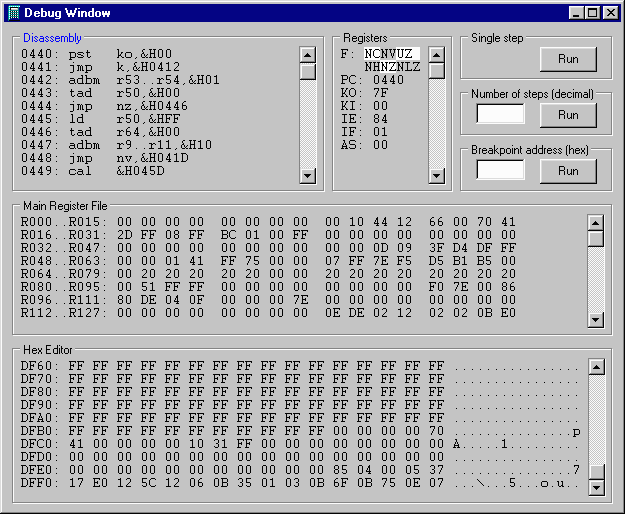FX-8000G emulator
The program works on PC-compatible machines with Microsoft Windows operating system.
Program version 09, updated 2021/02/06
 fx8000es.zip - Delphi sources
fx8000es.zip - Delphi sources
 fx8000em.zip - compiled executable
fx8000em.zip - compiled executable
Usage: extract the files into an empty directory, then run the program fx8000g.exe
 fx8000el.zip - Lazarus port (tested on Ubuntu Linux and Windows
fx8000el.zip - Lazarus port (tested on Ubuntu Linux and Windows


- Following files contain the memory images, and are loaded when the program is started:
rom0.bin - processor's internal 18kB ROM
rom1.bin - external 32kB ROM
charset.bin - LCD controller's internal character ROM of size 1.5kB
ram.bin - 8kB RAM
register.bin - processor's internal register file
- The updated
ram.bin and register.bin files are saved when the program is terminated.
If they weren't found, they will be created.
In such case the memory has to be initialised with the F8 button.
- The emulator can be operated with the mouse or the keyboard.
Special function keys:
Cursor keys: corresponding arrow keys
Home: SHIFT
End: ALPHA
Esc: AC
Delete: DEL
Enter: EXE
F3: suspends the code execution and opens the debugger window
F8: memory initialisation, equivalent to the button on the calculator's back side
Disassembly box
- On entry, the starting address matches the Program Counter, but it can be modified by clicking on the address in the first line.
New value must be confirmed with Enter.
- After clicking on a disassembled instruction, a new instruction can be typed.
As with the starting address, pressing Enter accepts the changes.
Only changes in the RAM area will be saved upon program termination, all ROM modifications will be lost.
Characteristics:
- labels and expressions aren't supported
- accepted are hexadecimal (with the prefix &H) and decimal numbers
Hex Editor box
- The HEX box allows viewing/changing the RAM contents only.
- It is possible to modify the starting address and the RAM contents by clicking on them.
Enter accepts the changes.
Registers box
- The contents of the registers can be modified by clicking on them.
Enter accepts the changes.
- The top area in the register box show the state of the upper six bits of the Flag register.
They can be modified as well.
Main register file box
- The contents of the registers can be modified by clicking on them.
Enter accepts the changes.
Program execution control
- Closing the debugger windows resumes the program execution without tracing.
- Pressing the button [Run] in the Single step group box executes a single machine code instruction.
- To execute a specified number of machine code instructions type the required value to the field in the Number of steps group box, then press the associated [Run] button.
- The Breakpoint group box allows to specify condition that determine when the program execution should be interrupted.
Currently it only compares the Breakpoint Address typed in the field with the Program Counter.
When they match, the program execution is stopped and the debugger window reappears.
Some parameters of the emulator can be customised by editing the fx8000g.ini file with any text editor.
Description of the contents of this file:
OscFreq=910- This setting specifies the emulated CPU clock frequency in kHz.
SelfTest=0- The value specifies the time in ca. 30-60ms units the TEST pads on the PCB are connected after starting the application.
Value of 0 should be used for normal operation.
Value of 20 is recommended for performing the self-test diagnostic routine.
To uninstall the emulator, simply delete the directory where it was installed.
The program doesn't modify anything outside its installation directory.
- The program includes a freeware component ThreadedTimer developed by Carlos Barbosa.
- The ROM image
rom0.bin had to be patched (swapped instructions at the locations &H02C6 and &H02C7) due to some unsupported property of the keyboard port.
- The quirks of the instructions RODM, SWPM, XCHSM, XCLSM (subtractions of the Carry bit) aren't emulated.
- The scrolling function of the LCD controller command $8 isn't supported.
- Bugs may still lurk in the
rom0.bin memory image.
![]() fx8000es.zip - Delphi sources
fx8000es.zip - Delphi sources![]() fx8000em.zip - compiled executable
fx8000em.zip - compiled executable![]() fx8000el.zip - Lazarus port (tested on Ubuntu Linux and Windows
fx8000el.zip - Lazarus port (tested on Ubuntu Linux and Windows
